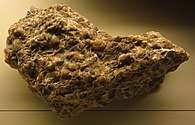Irlbach Sandstone
The Irlbach Sandstone is a Jurassic (Bifrons stage of the Toarcian) geologic formation located mostly on Regensburg, Germany.[1] It is a coeval unit for the marine Posidonia Shale, and has been identified as part of it on several works.[2][3][4] However, the last works focused on the zone didn't explain the formal status of the layers with the Posidonia Shale, where is either recovered as a different coeval unit or a changued sector with more possible terrestrial influence of this last one.[5]
| Irlbach Sandstone Stratigraphic range: Bifrons (Early Toarcian) ~179 Ma | |
|---|---|
Schlucht Pit near Regensburg, where strata of the Formation was found on the early 1900s, mixed with Posidonia Shale strata. | |
| Type | Geological formation |
| Unit of | Schwarzjura Group ("Black Jurassic") |
| Underlies |
|
| Overlies |
|
| Thickness | 3-15 m |
| Lithology | |
| Primary | Sandstone |
| Other | Bituminous, arenaceous, grey Shale |
| Location | |
| Coordinates | 48°51'02.3"N, 12°45'02.2"E |
| Region | Regensburg |
| Country | |
| Type section | |
| Named for | Irlbach, Germany |
| Named by | Ludwig von Ammon (As an Informal Unit)[1] |
| Year defined | 1875 |
Strata
The Major level was reported from the "Irbacher Schiefer" (Irlbach Slates, a now destroyed outcrop at the north of the town of the same name[4]) where a series of 7 m thick series of leafy slate outcrops (mostly from the Posidonia Shale or with strata from it) are developed, with the last 3–4 m being parallel to a series Sandstone levels, that overlain a small section of the marine strata.[1][6] This level is also characterized on the east side by bituminous fine-layered clay Marl (Posidonia Shale), that delevops parallel to the formation around 8–9 m on Amberg, and 10 m on Hirsehau.[7] Is on the southeast of the Naab River to the north of Irlbach, where the fine series of Sandstone-Limestone facies of the formation sits in the upper part of the Lower Toarcian strata, overlaying the marine deposits.[7] The local Slates where described soft and never too hard, partly dark gray to black, heavily impregnated with the Charcoal, clearly showing the remains of the stem, roots or other parts of plants. The slate levels that are coeval with the Sandstones change to a light gray to almost white slate made of muddy Clay material (Specially at the Keller Clay Pit and on Irlbach), where are deposited remains of the stem or other parts of the plants.[1] The Sandstone Layers are filled with Bifrons-aged Ammonites along with Clams of the genus Inoceramus.[6] Those last are referred as the Dactylioceras Sandstone by Pompeckj (1901), and the major outcrop was settled at the Lias-Epsilon (Early Toarcian) near Irlbach above the Posidonia Shale, and was latter also found to be present in the eastern half of Keilberg, on Grünthal, the Keller Clay Pit and the Schlucht Pit, where it develops to a maximun thickness of 15 m.[8] They overlay slightly bituminous, arenaceous, grey shales ( of the Falciferum Zone).[9] The strata of this layer is composed by sandy-clay lime and limestone with quartz pebbles on 2.5-2.8 m of the Dactylioceras Sandstone, that is a light gray, fine-grained lime sandstone with quartz pebbles, a lot of mica (in column with galena), wood residues, belemnites, the ammonite Dactylioceras commune, the bivalve Pseudomonotis substriata, all overlain by a last section with blue-black fine sand, very rich in mica.[6]
Environment
The Irbach Sandstone represents a series of Prograding sandstones with Ammonites, that follow a local Sea regression on the Bifrons substage of the Lower Toarcian.[6][7] Was part of the coast of the western Bohemian Massif, where a possible Parallic Coal basin was developed near the sea.[3] Mostly of the biota reported comes from marine settings, being nearly the same that the one reported from the coeval Posidonia Shale, altrougth shows marks of transportation and deposition on a marginal marine environment.[8] The Irbach Sandstone ecosystem is followed to the northwest by the Altdorf High biota, that recovers mostly marine fauna, but also several terrestrial biota, such as Pterosaurs and Turtles.[10] Local Sea level fluctuations in Altdorf are known to result in fossil shell concentrations.[11] This concentrations suggested that was a local regression what caused reworking and selective transport of left Meleagrinella valves from the basin margin to a more distal area.[11] The major argument to the regression was the progradation of Bifrons Irbach Sandstone over Falciferum shales at the basin margin confirmed by several later drillings.[6][7] There is needed a detailed sedimentological analysis of these marginal-marine Toarcian sandstones, being another theory that their progradation may rather reflect sea level highstand conditions.[12] Due to the presence of Plant remains & Insects (Coleoptera) is interpreted as a nearshore unit.[3] The presence of also abundant plant and coleopterans on the coeval biota of Oberpfalz links those biomas with terrestrial units.[13] The Climate on the region was mostly probably arid, due to the abundance of pollen of Classopollis (Cheirolepidiaceae coniferans) and other thermophile plants.[14] The local Carbon can be related to the increase of Wildfires, recorded also on the Lower Toarcian Blanowice Formation (that represents the eastern shore of the Bohemian Massif).[15]
Fossils
Brachiopoda
| Genus | Species | Stratigraphic position | Material | Notes | Images |
|---|---|---|---|---|---|
|
|
Cunchs |
A Brachiopodan, member of Nuculiade inside Discinida. |
||
|
|
Cunchs |
A Brachiopodan, member of Discinidae inside Discinida. The classification of the Discinidae is rather treated with confusion, due to the description and the identification of either extinct and extant genera and species. |
||
Bivalvia
| Genus | Species | Material | Location | Notes | Images |
|---|---|---|---|---|---|
|
|
|
A Clam, type member of the family Solemyidae inside Solemyida. |
| |
|
|
|
A Clam, member of the family Inoceramidae inside Myalinida. It was originally identified as Inoceramus cinctus. This genus is one of the main reported from the sandstone level. |
| |
|
|
|
A Scallop, member of the family Oxytomidae inside Pectinida. A rather abundant genus, that has been seen as result of periodical accumulation of cunchs due to a local marine regression. |
| |
Cefalophoda
Various Ammonite & Belemnite Fossils wheren´t identified.[7]
| Genus | Species | Location | Material | Notes | Images |
|---|---|---|---|---|---|
|
|
Multiple Specimens. |
A Nautilidae Nautilidan. This genus is the only reported Nautiloid locally, and has been found on the marginal marine section of the formation. The cunchs show signs of transportation. |
 | |
|
|
Multiple Specimens. |
An Ammonite, the type genus of the family Lytoceratidae inside Ammonitida. |
||
|
|
Multiple Specimens. |
An Ammonite, the type genus of the family Hildoceratidae inside Hildoceratoidea. A genus washed from the open marine deposits of the Posidonia Shale. |
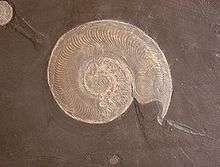 | |
|
|
Multiple Specimens. |
An Ammonite, the type genus of the family Hammatoceratidae inside Ammonitida. |
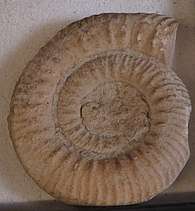 | |
|
|
Multiple Specimens. |
An Ammonite, the type genus of the family Dactylioceratidae inside Ammonitida. This is the most abundant genus reported from the layers of the formation, and the genus that give the original Dactylioceras Sandstones name to the outcrop.[8] |
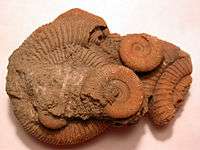 | |
|
|
Multiple Specimens. |
An Belemnite, member of the family Belemnitida. Was identified originally as Belemnites clavatus.[8] |
||
|
|
Multiple Specimens. |
An Belemnite, member of the family Megateuthididae inside Belemnoidea. Was identified originally as Belemnites tripartitus.[8] |
||
Thoracica
| Genus | Species | Location | Material | Notes | Images |
|---|---|---|---|---|---|
|
|
Various individuals |
A phospatic-shelled Cirripede, type genus of the family Eolepadidae inside Lepadomorpha. This genus was a benthic-nearshore representative of its family, and had been found on Pliensbachian layers from the same location. |
 Modern genus of Goose Barnacles where the most related taxa to Eolepas | |
Insecta
Several Insect remains where quoted, but never described. Insects are a common terrestrial animals that where proabaly drifted to the sea due to Moonsonal conditions present Locally.[3]
| Genus | Species | Location | Material | Notes | Images |
|---|---|---|---|---|---|
|
|
Single Elytron |
A Beetle of uncertain placement, it resembles superficially the family Trachypachidae. The presence of Beetles locally indicates the provenance from a near emerged land, and are the main source to stablish the range of the coast of the toarcian Bohemian Massif. This elytron was never studied, and is the only insect remain described from a nearshore deposit on the Bohemian Massif. It was found linked to a Parallic coal deposition, being probably washed to the shore by a small river.[3] |
 Local beetles where probably related with Trachypachus | |
Actinopteri
Fish Teeth, Scales and Spines where quoted, but not described.[8]
| Genus | Species | Location | Material | Notes | Images |
|---|---|---|---|---|---|
|
|
Various specimens. |
The youngest representative of the family Saurichthyidae inside Chondrostei, known for its large jaws, similar to modern Belonidae. Was identified as Belonostomus acutus, considered junior synonym of this genus. |
| |
|
|
Various Complete and Incomplete specimens |
A deep-bodied Neopterygian, Type member of the family Dapediidae. The main Bony fish reported locally, the Dapedium specimens where mostly washed from the coeval Posidonia Shale, with the exception of some Dapedium sp., that show adaptations to live on nearshore-lagoonal settings. Dapedium was common on the late Triassic and early Jurassic, characterized by a deep body, round and depending. Its teeth suggest a diet on hard molluscs and crustaceans. |
| |
Ichthyosauria
| Genus | Species | Location | Material | Notes | Images |
|---|---|---|---|---|---|
|
|
Fragments of ribs |
An Icthyosaur of uncertain placement, probably a member of the family Stenopterygiidae inside Thunnosauria. It was identified as Ichthyosaurus sp., but probably represent fossils of the genus Stenopterygius, know from Toarcian strata from the Posidonia Shale. The find on a marginal marine-lagoonar environment along with the small size of the speciments can suggest the presence of an Ichthyosaur nursery. |
 Restoration of Stenopterygius, the most common Icthyosaur on the German Toarcian | |
Plantae
A great amount of fragments of wood have been reported, but never studied.[1][6][7]
| Genus | Species | Location | Stratigraphic position | Material | Notes | Images |
|---|---|---|---|---|---|---|
|
|
|
|
Affinities with Araucariaceae or Cheirolepidiaceae inside Pinales. Pagiophyllum araucarinum predominates among the two types of leafy coniferous branches that have become known from the Posidonia. However, there is no indication whether this fact reflects their respective share in the vegetation of the delivery area. Cheirolepidiaceae Pollen is the most abundant and diverse found on the formation, what is correlated with the abundance of this genus. Other factor that puts local Pagiophyllum on Cheirolepidiaceae is the dominance of an arid climate, the preferred for this type of conifers. |
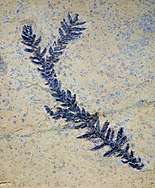 | |
|
|
|
|
A possible ancestral member of the Sequoioideae or Callitroideae inside Cupressaceae. Was originally related to the genus "Quasisequoia" couttsiae, as a sister taxa to Sequoia jeholensis. The later studies suggest affinities with large modern redwoods, but others find relationships with the modern genus Fitzroya cupressoides. Both Genera are related with relatively humid ecosystems, while Widdringtonites is known from an Arid setting. |
| |
|
|
|
|
A member of Williamsoniaceae inside Bennettitales. It has been interpreted as a cycad in the family Cycadaceae or a Bennettitalean plant. Leaflets somewhat removed, oval-oblong, a little narrower near the base, rounded at the tip, nerves partially diverging from the base towards the edge. It was assigned to Pterophyllum oblongifolium and on the genus Glossozamites. This genus was the leaf of arboreal Bennetites, similar in appearance to the modern Encephalartos woodii, with leaves nearly identical to the modern Zamia furfuracea. |
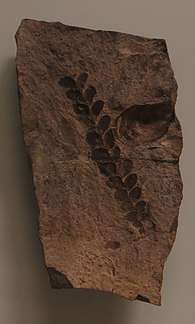 | |
See also
- List of fossiliferous stratigraphic units in Germany
- List of fossiliferous stratigraphic units in Poland
- Toarcian turnover
- Toarcian formations
- Marne di Monte Serrone, Italy
- Calcare di Sogno, Italy
- Sachrang Formation, Austria
- Saubach Formation, Austria
- Krempachy Marl Formation, Poland and Slovakia
- Lava Formation, Lithuania
- Azilal Group, North Africa
- Whitby Mudstone, England
- Fernie Formation, Alberta and British Columbia
- Poker Chip Shale
- Whiteaves Formation, British Columbia
- Navajo Sandstone, Utah
- Los Molles Formation, Argentina
- Mawson Formation, Antarctica
- Kandreho Formation, Madagascar
- Kota Formation, India
- Cattamarra Coal Measures, Australia
References
- Ammon, L. V. (1875). Die Jura-Ablagerungen zwischen Regensburg und Passau. Abhandlungen des zoologisch-mineralogischen Vereins in Regensburg, 10.
- DER, D. H., & SCHICHTEN, O. (1987). liess den Wunsch entstehen, einen Überblick über die Hornsteinlagerstätten der Region zu besitzen–nur. In Proceeding of the International Conference on Prehistoric Flint Mining and Lithic Raw Material Identification in the Carpathian Basin (p. 129). Magyar Nemzeti Múzeum.
- Ansorge, J. (2003). Insects from the lower Toarcian of middle Europe and England. Acta zoologica cracoviensia, 46(SUPPL.), 291-310.
- Keim, G., Glaser, S., & Lagally, U. (2004). Geotope in Niederbayern (Vol. 4). Bayerisches Geologisches Landesamt.
- Oschmann, F. (1961). Mitteilungen über den Jura und die Kreide bei Kelheim und Regensburg. Paläontologische Zeitschrift, 35(3-4), 171-178.
- Putzer, H. (1939). Der Jura am Keilberg bei Regensburg. Neues Jahrbuch für Mineralogie, Geologie und Paläontologie, Beilage, 82, 90-154.
- Bauberger, W., Cramer, P., & Tillmann, H. (1969). Geologische Karte von Bayern 1: 25000. Erläuterungen zum Blatt Nr. 6938 Regensburg. München (GLA).
- Pompeckj, J. F. (1901). Die Jura-Ablagerungen zwischen Regensburg und Regenstauf: ein Beitrag zur Kenntnis der Ostgrenze des Fränkischen Jura. Piloty & Loehle.
- Krumbeck, L. (1943): Zur Stratigraphie und Faunenkunde des Lias zeta in Nordbayern, Teil 1.—Z. dtsch. geol. Ges.,95, 279–340
- Arp, G., Aiglstorfer, M., Havlik, P., Krause, T., Schulbert, C., & Seppelt, S. (2014). New exposure of the Ludwigskanal section near Dörlbach–a key section for the Lower Jurassic in the Franconian Alb, Southern Germany. Zeitschrift der Deutschen Gesellschaft für Geowissenschaften, 165(2), 163-177.
- Birzer, F. 1936. Die Monotis-Bank in den Posidonien-Schiefern, besonders Frankens. Abhandlungen der Geologischen Landesuntersuchung am Bayerischen Oberbergamt 26: 3–32.
- Arp, G., & Gropengießer, S. (2016). The Monotis–Dactylioceras Bed in the Posidonienschiefer Formation (Toarcian, southern Germany): condensed section, tempestite, or tsunami-generated deposit?. PalZ, 90(2), 271-286.
- BRACHERT, T. C. (1987): Makrofossilführung der "Siemensi-Geoden" (Mittlerer Lias Epsilon, Unteres Toarcium) von Kerkhofen/Oberpfalz (Bayern): Neue Insekten- und Pflanzenfunde. – Geologische Blätter für Nordost-Bayern und angrenzende Gebiete, 37(3/4): 217–240, 3 Abb., 2 Tab., Taf. 17–20; Erlangen.
- G. Suan, B.L. Nikitenko, M.A. Rogov, F. Baudin, J.E. Spangenberg, V.G. Knyazev, L.A. Glinskikh, A.A. Goryacheva, T. Adatte, J.B. Riding, K.B. Föllmi, B. Pittet, E. Mattioli, C. Lécuyer Polar record of Early Jurassic massive carbon injection Earth and Planetary Science Letters, 312 (2011), pp. 102-113
- Pointer, R. (2019). Fire & Global Change During Key Intervals of the Late Triassic & Early Jurassic with a Focus on the Central Polish Basin.
- Brunhuber, A. (1917). Die geologischen Verhältnisse von Regensburg und Umgebung; mit einer Übersichtskarte, zwei Profiltafeln. Naturwissenschaftl. Verein.

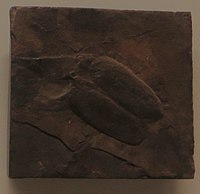
.jpg)
